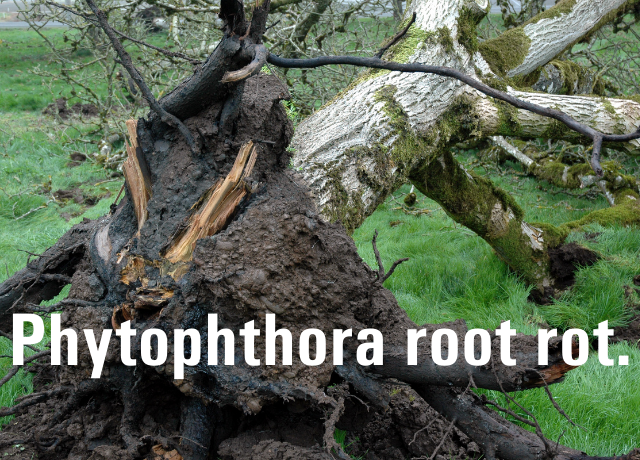
Phytophthora?
Phytophthora root rot is one of the most common causes of root and stem decay in trees and shrubs and removal of the infected plant may be your only option for a very compromised tree.
Symptoms include wilting, sparse foliage, and branch dieback. It often gets progressively worse until the plant dies.
It is caused by microscopic fungus-like organisms. They can survive in the soil without a host plant for several years and primarily occurs in heavy or water-logged soils. It enters the plant via a wound created by mechanical or natural methods (insects).
Often by the time the symptoms appear the decay is well established.
Examination below the ground could reveal a poor root system with rotting feeder roots and larger root decay.
Infections will often invade the base of the tree and will appear as an inverted V with black discoloration or weeping.
There are some chemical treatments that may control phytophthora but the removal of a very compromised tree may be the only option. You could also try a bio fungicide treatment where competing fungi are introduced.
The best treatment is prevention. It starts with choosing your site and creating good drainage in the hole you have prepared for your new tree. Treat the roots carefully they are the lifeblood of the tree and don’t plant your trees too deep by ensuring the root collar is exposed. Don’t mow over surface roots and create wounds!
Phytophthora spores can travel in water and move to neighboring trees so if it is in your soil, keep an eye on your other trees. An infected tree at the top of a hill may present a threat to the trees below.
Healthy trees are far more likely to be able to fight off infection, so ensuring your tree is well maintained by pruning, removing deadwood annually, and maintaining soil health by mulching will all help. Keep an eye out for destructive pests and treat them accordingly to give your trees the best chance of fighting off potentially fatal damage.
If you are wanting to replant in the area, choose phytophthora-resistant plant species.